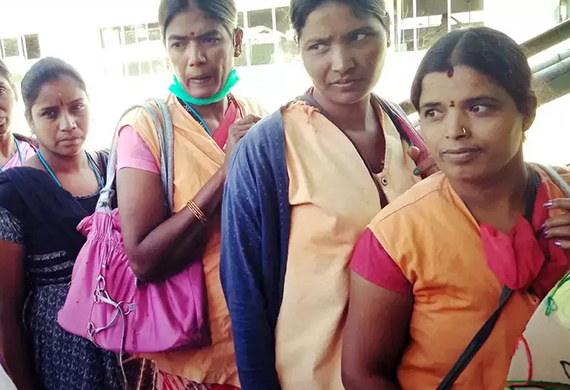
Unemployment Rate for Women Falls, Government takes steps to encourage Women's Employment
By: Navyasri, Content Writer, Women Entrepreneur | Thursday, 29 July 2021
Unemployment rate for women fell to 4.2 percent in 2019-20 from 5.1 percent in 2018-19. (NSO) said National Statistical Office's Periodic Labour Force Survey (PLFS). The National Statistics Office (NSO) is a branch of the Ministry of Statistics and Program Implementation.
According to the PLFS for 2019-20, women's share of total employment generated (in person days) under MGNREGS in 2020-21 has increased to around 207 crore person days. Women's labor-force participation (LFPR) has risen from 24.5 percent in 2018-19 to 30.0 percent in 2019-20.
For the first time in India, female school teachers outnumber male teachers. The government has launched a number of initiatives to increase women's labor-force participation.
To encourage women's employment, a number of protective provisions have been incorporated into labour laws to create a welcoming work environment for female employees.
These include increasing paid maternity leave from 12 to 26 weeks, requiring creche facilities in establishments with 50 or more employees, allowing women to work night shifts with adequate safety measures, and so on.
The government has also decided to allow women to work in aboveground mines, including opencast workings, between 7 p.m. and 6 a.m.For belowground mines, women will be allowed to work between 6 a.m. and 7 p.m. in technical, supervisory, and managerial positions where continuous presence is not required.
Furthermore, in order to improve female workers' employability, the government provides training through a network of Women Industrial Training Institutes, National Vocational Training Institutes, and Regional Vocational Training Institutes.
The government has taken a number of steps to increase employment in the country, including encouraging large-scale projects and increasing public spending on programmes such as the Prime Minister's Employment Generation Programme (PMEGP), the Mahatma Gandhi National Rural Employment Guarantee Scheme (MGNREGS), Pt. Deen Dayal Upadhyaya Grameen Kaushalya Yojana (DDU-GKY) and Deendayal Antodaya Yojana-National Urban Livelihoods Mission (DAY-NULM).
The Aatmanirbhar Bharat RozgarYojna (ABRY) Scheme was launched on October 1, 2020, to incentivize the creation of new jobs while also providing social security benefits and restoring lost jobs. This scheme reduces employers' financial burden and encourages them to hire more workers.
The Government of India has provided for a two-year period under ABRY for both the employees' share (12 percent of wages) and the employer's share (12 percent of wages) of contribution payable or only the employees' share, depending on the employment strength of the EPFO registered establishments.
Those who lost their jobs during Covid-19 and did not join any EPF-covered establishment before September 30, 2020 are considered new employees under the scheme.The deadline for registering as a beneficiary under the scheme has been moved from June 30, 2021 to March 31, 2022.
As of July 12, 2021, a total benefit of approximately Rs 993 crore had been distributed through 84,390 establishments to over 22 lakh beneficiaries, including 5.88 lakh women beneficiaries.
The government is incentivizing employers to create new jobs by providing social security benefits. Under the scheme, the Government of India pays the Employer's full contribution, i.e. 12 percent towards EPF and EPS both (as admissible from time to time), to new employees through EPFO for a period of three years.
The deadline for registering a beneficiary through an establishment was March 31, 2019. Beneficiaries who registered before March 31, 2019 will receive benefits for three years from the date of registration under the scheme.
As of June 14, 2021, 1.21 crore beneficiaries had received benefits under PMRPY, including 26.05 lakh women beneficiaries.
The government has increased the MGNREGA wage from Rs 182 to Rs 202 per day, benefiting nearly 13.62 crore families. Women's share of total employment generated (in person days) under MGNREGS has increased from approximately 145.35 crore person days in FY 2019-20 to approximately 207 crore person days in FY 2020-21.
The government launched Pradhan Mantri Mudra Yojana (PMMY) to facilitate self-employment, among other things. Under PMMY, micro/small business enterprises and individuals can apply for collateral-free loans of up to Rs 10 lakh to help them start or expand their businesses. Approximately 70 percent of the loans have gone to women entrepreneurs.
Any Indian citizen with a business plan for a non-farm sector income generating activity such as manufacturing, processing, trading, or service sector and a credit requirement of less than Rs 10 lakh can approach a Bank, MFI, or NBFC for Micro Units Development & Refinance Agency Ltd. (MUDRA) loans under the Pradhan Mantri Mudra Yojana (PMMY).
The interventions have been named 'Shishu’ which will cover loans upto 50,000; 'Kishor’ covering loans above 50,000 and upto 5 lakh; and 'Tarun’ which will cover loans above 5 lakh and upto 10 lakh respectively, to represent the stage of growth / development and funding needs of the beneficiary micro unit / entrepreneur, as well as to serve as a reference point for the next phase of graduation / growth to look forward to. It would be ensured that at least 60% of the credit goes to Shishu Category Units, with the remainder going to Kishor and Tarun Categories.


.jpg)



